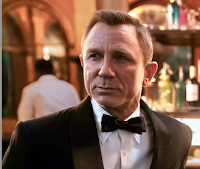We saw the long-awaited James Bond film recently. And not surprisingly, I began this review with the wrong title, not that it matters. The films are formulaic and could easily be titled “James Bond 1, James Bond 2,” in the style of the Fast and Furious enterprise.
So, to recap, we now have: Die Another Day, Live and Let Die, No Time to Die and Tomorrow Never Dies
and the related: License to Kill and A View to a Kill.
Sheesh, has anyone considered making a parody called, “Die, Already?” Well, hold onto that thought. I’ll try hard not to spoil anything.
But the title is not the only thing that makes these films memorable. Think back to the music that begins each journey into Bond’s world - shaken, not stirred. Music, after all, rivets Bond films into the soundtrack of their time, with only the hottest current pop stars invited to attend.
I believe Paul McCartney’s “Live and Let Die” is the ultimate score. In Paul’s typically schmaltzy, Uncle Albert melodic style, augmented by Sir George Martin’s orchestral genius, it lures you in for a close look at the coming explosion of sound, a wall of pounding chaos best accompanied on stage by fireworks.
Shirley Bassey’s “Goldfinger” comes to mind, and Adele’s Oscar winning “Skyfall,” but Madonna is pretty much forgotten for “Die Another Day.”
In No Time to Die we have Billy Eilish and brother Finneas co-authoring the title song, performed in her about-to-fall-asleep style, but actually using her pipes in a couple of places and singing more like Carly Simon did in “Nobody Does it Better.” Time will tell whether Billy will be remembered or fade quickly from her minutes of fame in our social media pandemic reality.
This is a very long film at almost three hours. In fact, it is the longest Bond film, and it feels like it, but it has enough action, chases, sub plots and betrayals to keep it interesting.
Ralph Fiennes is back again in the roll of “M,” casually referred to here by Bond as Mallory. He played Gareth Mallory when Judi Dench was M in Skyfall. Also returning is Ben Whishaw as “Q” (for Quartermaster by the way), with the usual array of gadgets that always seem about to explode when first examined. Q has a secret (to the audience) that is delicately revealed in this appearance. He played an amazing rendition of Uriah Heep in 2019’s The Personal History of David Copperfield.
One of the greatest arch-villains in the history of Bond films returns from his last appearance, incarcerated in Silence of the Lambs style, caged and shackled within an ultra-super-max security setting. Ernst Stavro Blofeld has been around for almost sixty years as the head of the evil organization SPECTRE, played by such notables as Donald Pleasance and Telly Savalas. But Christoph Waltz brings his sinister best to this role with his taunting, German accent-laced mind games.
For Bond fans who relish seemingly inhuman villains, like “Jaws” in Moonraker, here we have Cyclops. Use your imagination, but his character is the source of the inevitable Bond puns we’ve come to love, but not really expect all that much from Daniel Craig.
Locations are stunning, from Italy to Norway, Jamaica to Cuba (faked sets). There are so many bad guys it’s hard to keep track, but ultimately Rami Malek as Lyutsifer Safin takes top honors as a self-proclaimed God who, despite his vast wealth and trendy technology, can’t make it to the dermatologist for a much-needed dermabrasion.
There are several strong female co-stars in No Time to Die along with the ever-present Moneypenny. One, an agent (Lashana Lynch as Nomi) under the direction of M, another seemingly ditsy newbie (Ana de Armas as Paloma) with surprisingly refined skills and a dress held in place by superglue, and ultimately a love interest (Lea Seydoux as Madeleine), since at the end of the day this is a love story, as are all Bond films.
No Time to Die (2021) runs 2 hours, 43 minutes and is rated PG-13.




